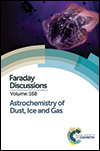The formation of glycine and other complex organic molecules in exploding ice mantles
Abstract
Complex Organic Molecules (COMs), such as propylene (CH3CHCH2) and the isomers of C2H4O2 are detected in cold molecular clouds (such as TMC-1) with high fractional abundances (Marcelino et al., Astrophys. J., 2007, 665, L127). The formation mechanism for these species is the subject of intense speculation, as is the possibility of the formation of simple amino acids such as glycine (NH2CH2COOH). At typical dark cloud densities, normal interstellar gas-phase chemistries are inefficient, whilst surface chemistry is at best ill defined and does not easily reproduce the abundance ratios observed in the gas phase. Whatever mechanism(s) is/are operating, it/they must be both efficient at converting a significant fraction of the available carbon budget into COMs, and capable of efficiently returning the COMs to the gas phase. In our previous studies we proposed a complementary, alternative mechanism, in which medium- and large-sized molecules are formed by three-body gas kinetic reactions in the warm high density gas phase. This environment exists, for a very short period of time, after the total sublimation of grain ice mantles in transient co-desorption events. In order to drive the process, rapid and efficient mantle sublimation is required and we have proposed that ice mantle ‘explosions’ can be driven by the catastrophic recombination of trapped hydrogen atoms, and other radicals, in the ice. Repeated cycles of freeze-out and explosion can thus lead to a cumulative molecular enrichment of the interstellar medium. Using existing studies we based our chemical network on simple radical addition, subject to enthalpy and valency restrictions. In this work we have extended the chemistry to include the formation pathways of glycine and other large molecular species that are detected in molecular clouds. We find that the mechanism is capable of explaining the observed molecular abundances and complexity in these sources. We find that the proposed mechanism is easily capable of explaining the large abundances of all three isomers of C2H4O2 that are observationally inferred for star-forming regions. However, the model currently does not provide an obvious explanation for the predominance of methyl formate, suggesting that some refinement to our (very simplistic) chemistry is necessary. The model also predicts the production of glycine at a (lower) abundance level, that is consistent with its marginal detection in astrophysical sources.
- This article is part of the themed collection: Astrochemistry of Dust, Ice and Gas

 Please wait while we load your content...
Please wait while we load your content...